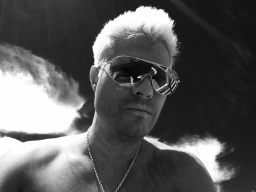Growing up in the Midwest, it was a common practice to take weekend road trips. Living in Hawaii is a different story. To experience a weekend getaway, island hopping is the key to a temporary change in surroundings. Having visited Kona for a day earlier this year on an island cruise, I decided to return for a weekend to do some more exploring with the world’s greatest traveling companion, my five-pound Yorkie, Spike.
Kona is on the southwest coast of Hawaii, which is known as the “Big Island.” There are eight islands total in the chain: Hawaii, Oahu, Maui, Kahoolawe, Lanai, Molokai, Kauai and Niihau. The island of Hawaii is the youngest and largest island in the Hawaiian chain. Nearly twice as big as all of the other Hawaiian Islands combined (hence, its nickname, “Big Island”), its sheer size is awe-inspiring. You can travel through all but four of the world’s different climate zones here, ranging from tropical to tundra, a result of the shielding effect and elevations of the massive volcanoes Maunakea and Maunaloa.
After a short 45 minute flight from Honolulu, I took a cab to the King Kamehameha Hotel. Situated along the gentle curve of Alii Drive and Kailua Bay, Kailua-Kona is a romantic seaside village that takes advantage of the protected bay and sunny Kona coastline. The hotel sits directly across from Kailua Pier, which is home to some of the finest big-game fish in in the world. One of the first things you notice is the bright, azure blue waters around Kona and other shores along the Big island. The view from my room reminded me of the Mediterranean.

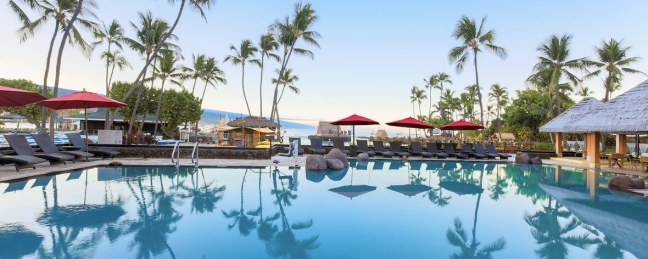

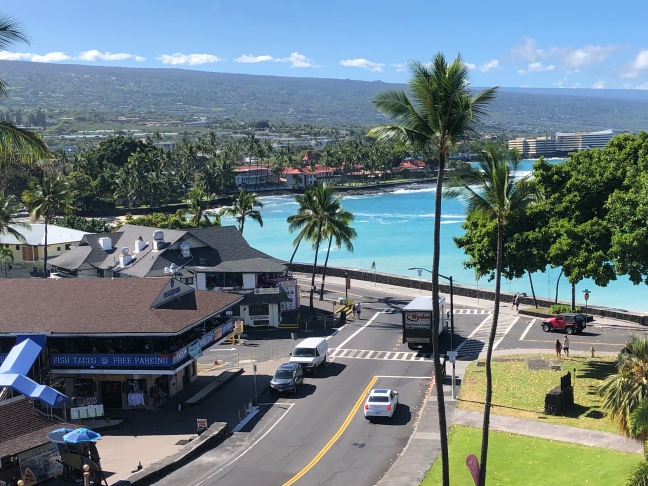 I walked along the sea wall with waves crashing up onto the sidewalk and found myself at an open air restaurant called The Fish Hopper. With locations in Monterey, California and Kailua-Kona, the restaurant specializes in fresh seafood as well as steaks and features breathtaking views of the Pacific Ocean. I opted for one of the daily features, Parmesan encrusted mahi mahi.
I walked along the sea wall with waves crashing up onto the sidewalk and found myself at an open air restaurant called The Fish Hopper. With locations in Monterey, California and Kailua-Kona, the restaurant specializes in fresh seafood as well as steaks and features breathtaking views of the Pacific Ocean. I opted for one of the daily features, Parmesan encrusted mahi mahi.
 After dinner, I continued walking along Alii Drive where I stumbled upon San Francisco Bay Gourmet Coffee Bar, which features locally grown coffee and Tropical Dreams locally made ice cream. Unable to decide on a flavor, I ended up trying three: mud pie, kona coffee and macadamia nut. They also have açaí bowls, overnight oats, and baked goods.
After dinner, I continued walking along Alii Drive where I stumbled upon San Francisco Bay Gourmet Coffee Bar, which features locally grown coffee and Tropical Dreams locally made ice cream. Unable to decide on a flavor, I ended up trying three: mud pie, kona coffee and macadamia nut. They also have açaí bowls, overnight oats, and baked goods.
The next morning I rented a car and drove to St. Benedict Painted Church, which is located about 40 to 45 minutes from downtown Kona. From the intersection of Highway 11 and Highway 160, turn towards the ocean (makai) and follow Hwy 160 for about a mile. Right after the green one mile road marker, you will see a sign for “Painted Church.” Turn right onto Painted Church Road and follow the winding road for .3 miles. Turn right into the church property.
Overlooking beautiful and historic Kealakekua Bay, St. Benedict’s Painted Church is a fascinating place to visit on your journey to the Big Island of Hawaii. Located in the famous Kona coffee growing region, it is the jewel of South Kona, at a place called Honaunau. While it is an important historical site, it is still a vibrant parish, with outreach programs to take care of those in need and to provide medical services for the local community.
The Painted Church was erected in 1899 by Father John Velghe. Without any professional training and using house paint on ordinary wood, he beautified the church with his paintings, which served a dual purpose. In those days few Hawaiians could read and so he taught the Bible stories with pictures-most successfully.
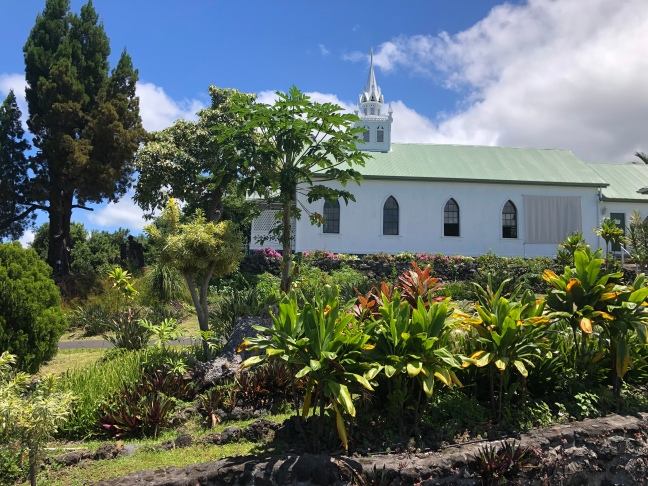

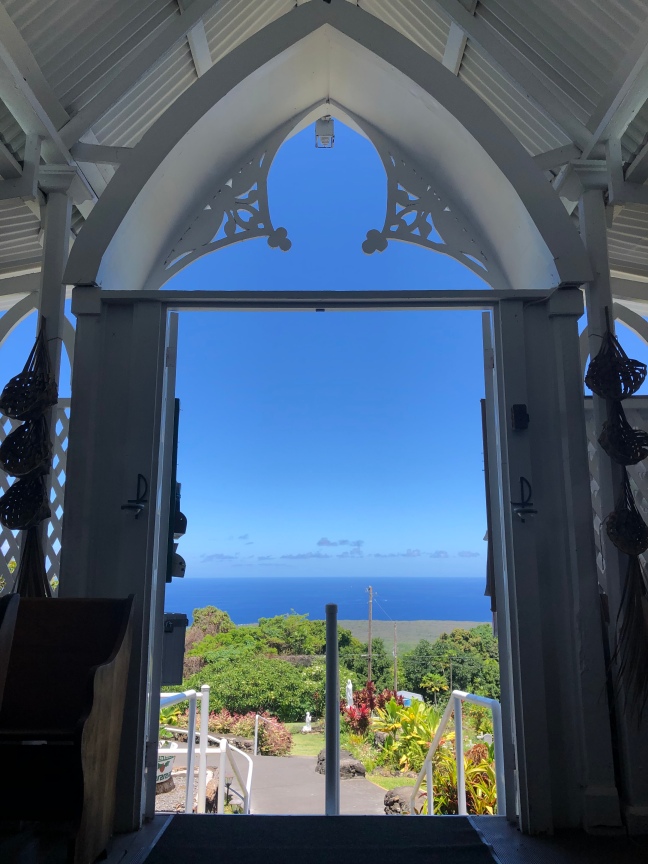


 From the church, I made my way to Pu’uhonua O Hōnaunau National Historical Park (Place of Refuge). Pu’uhonua O Honaunau is an ancient place of sanctuary and one of the best spots to learn about the wealth of Hawaiian culture.
From the church, I made my way to Pu’uhonua O Hōnaunau National Historical Park (Place of Refuge). Pu’uhonua O Honaunau is an ancient place of sanctuary and one of the best spots to learn about the wealth of Hawaiian culture.
In old Hawai’i, if you had broken a law, the penalty was death. Perhaps you had entered into an area that was reserved for only the chiefs, or had eaten forbidden foods. Laws, or kapu, governed every aspect of Hawaiian society. The penalty for breaking these laws was certain death. Your only option for survival was to elude your pursuers and reach the nearest pu’uhonua, or place of refuge.
As you enter, the great wall rises up before you marking the boundaries between the royal grounds and the sanctuary. Many ki’i (carved wooden images) surround the Hale o Keawe temple, housing the bones of the chiefs that infuse the area with their power or mana. If you reached this sacred place, you would be saved.
Today, you may visit Pu’uhonua o Hōnaunau National Historical Park, and still feel the spirit of peace and forgiveness that continues to surround and bless this special place. There is also world class snorkeling in this gorgeous coastal area.


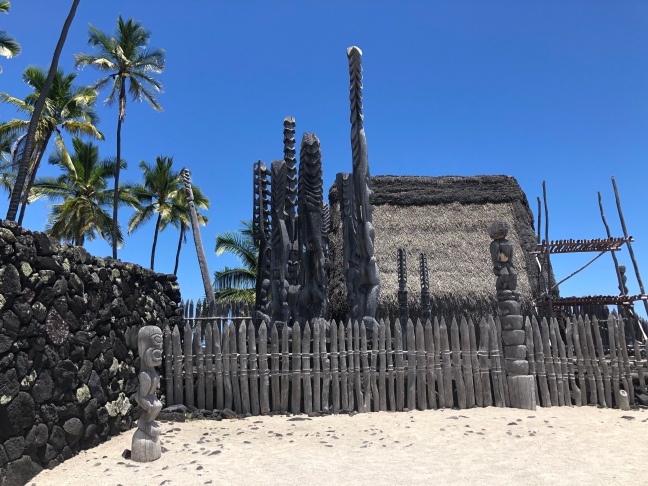

 From the park I drove north through the Kohala coast. Kohala is a land of extremes, from the jagged lava fields surrounding Waikaloa to lush mountain ranch lands in Waimea. Waimea is also known as Kamuela, which happens to by my partner’s Hawaiian name (Samuel in English).
From the park I drove north through the Kohala coast. Kohala is a land of extremes, from the jagged lava fields surrounding Waikaloa to lush mountain ranch lands in Waimea. Waimea is also known as Kamuela, which happens to by my partner’s Hawaiian name (Samuel in English).
Kamuela/Waimea was named one of the 25 coolest towns in America in 2018 by the Matador Network. Located on an inland plateau at the north end of the Big Island of Hawaii, this is where the cowboy West meets old school Hawaii. It’s home to Parker Ranch, the largest ranch in Hawaii and employer of many of the town’s residents. Here, you’re as likely to see a paniolo, or Hawaiian cowboy, cruising through town on his horse as you are a surfer with a board under her arm.
 With an elevation over 2,600 feet, Waimea/Kamuela is cooler than the island’s coastal towns. It also lies at the crossroads of the Big Island’s lush and wet windward side and its sunny and dry leeward coast — everything grows here. It holds one of the best farmers markets you’ll ever go to and is packed with farm-to-table restaurants that are consistently rated as some of the best on the islands.
With an elevation over 2,600 feet, Waimea/Kamuela is cooler than the island’s coastal towns. It also lies at the crossroads of the Big Island’s lush and wet windward side and its sunny and dry leeward coast — everything grows here. It holds one of the best farmers markets you’ll ever go to and is packed with farm-to-table restaurants that are consistently rated as some of the best on the islands.
Lilikoi Café, near the Parker Ranch, offers a scrumptious selection of gourmet salads, sandwiches and baked goods. I opted for the combo plate of three specialty salad selections served over a bed of Manoa lettuce with homemade lilikoi (passion fruit) dressing.
 I drove through Historic Honoka’a Town, which is where my partner’s mom’s Hawaiian lineage is traced. Her great grandfather Rickard was the town sheriff and the family homestead is now a Salvation Army. The North Hawaiʻi Education and Research Center (NHERC), part of the University of Hawaii Hilo, features an exhibit space all about the Rickard family, for which a street is also named.
I drove through Historic Honoka’a Town, which is where my partner’s mom’s Hawaiian lineage is traced. Her great grandfather Rickard was the town sheriff and the family homestead is now a Salvation Army. The North Hawaiʻi Education and Research Center (NHERC), part of the University of Hawaii Hilo, features an exhibit space all about the Rickard family, for which a street is also named.
 Much of the Big Island is a rural dream of wide-open spaces, and the Hamakua region’s small towns, including Honoka’a and Kukuihaele, have a classic small town charm. About a six mile drive from Honoka’a is the Waipio Valley Lookout. I had seen this breathtaking black sand beach with mountain backdrop while watching “Scenic Hawaii” on the television at home and had to see it for myself. Rich in history and natural beauty, the Waipio Valley is best viewed from the Waipio Valley Lookout.
Much of the Big Island is a rural dream of wide-open spaces, and the Hamakua region’s small towns, including Honoka’a and Kukuihaele, have a classic small town charm. About a six mile drive from Honoka’a is the Waipio Valley Lookout. I had seen this breathtaking black sand beach with mountain backdrop while watching “Scenic Hawaii” on the television at home and had to see it for myself. Rich in history and natural beauty, the Waipio Valley is best viewed from the Waipio Valley Lookout.

 Just down the hill is the Waipio Valley Artworks Café and Gallery, exclusively featuring Hawaii Island artists and koa furniture. I chatted with the shopkeeper, Midge who also told me about the Waipio Valley Shuttle, a four-wheel drive tour of the valley where you see 1,200 foot waterfalls, roaming wild horses and taro fields.
Just down the hill is the Waipio Valley Artworks Café and Gallery, exclusively featuring Hawaii Island artists and koa furniture. I chatted with the shopkeeper, Midge who also told me about the Waipio Valley Shuttle, a four-wheel drive tour of the valley where you see 1,200 foot waterfalls, roaming wild horses and taro fields.
 From the Waipio Valley, I made my way to the Waikoloa resort area where recent episodes of “The Real Housewives of Beverly Hills” were filmed at the Marriott Beach Resort. The housewives were on island for the wedding of Camille Grammar, who owns a home in one of the elite private communities in the area. Across from the Marriott are the King’s Shops, featuring restaurants and retail on a man-made lake. I couldn’t resist a Tommy Bahama silk aloha shirt that is exclusive to the islands and is new to the collection—it features vibrant sunset colors, palm trees and a giant hula dancer embroidered on the back.
From the Waipio Valley, I made my way to the Waikoloa resort area where recent episodes of “The Real Housewives of Beverly Hills” were filmed at the Marriott Beach Resort. The housewives were on island for the wedding of Camille Grammar, who owns a home in one of the elite private communities in the area. Across from the Marriott are the King’s Shops, featuring restaurants and retail on a man-made lake. I couldn’t resist a Tommy Bahama silk aloha shirt that is exclusive to the islands and is new to the collection—it features vibrant sunset colors, palm trees and a giant hula dancer embroidered on the back.
The most expensive resort on the island is the exclusive Four Seasons Hualalai. I made it there just in time to watch the sun setting over the resort and disappearing into the ocean on the horizon. The Beachtree restaurant on the water’s edge features live Hawaiian musicians and a menu of fresh seafood, pizza and burgers.

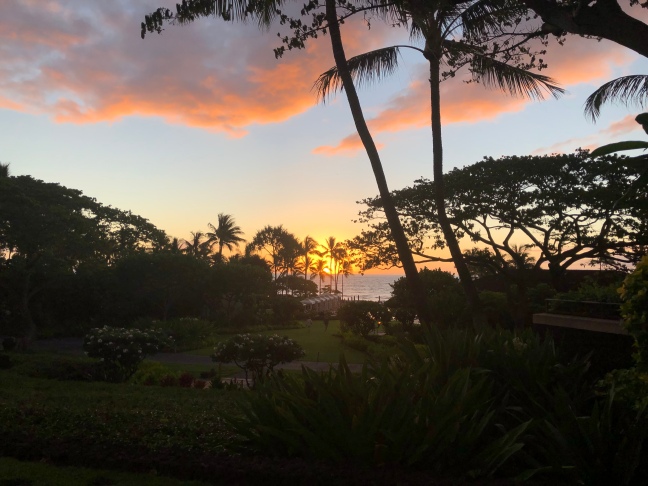
 On Sunday afternoon before heading home, I visited the Hulihe’e Palace. Located across the street from Mokuaikaua Church, on the scenic Kailua Bay’s shoreline, this is one of the most important historic structures in Kailua. Built in the 1800’s for Hawaiian royalty, it is today a fascinating museum dedicated to preserving Hawaii’s unique cultural heritage.
On Sunday afternoon before heading home, I visited the Hulihe’e Palace. Located across the street from Mokuaikaua Church, on the scenic Kailua Bay’s shoreline, this is one of the most important historic structures in Kailua. Built in the 1800’s for Hawaiian royalty, it is today a fascinating museum dedicated to preserving Hawaii’s unique cultural heritage.

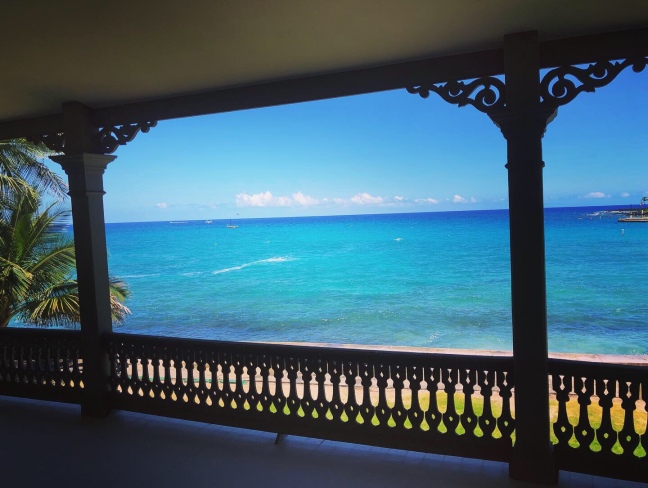
 I walked to the opposite end of Alii Drive to the Royal Kona Resort featuring Don The Beachcomber Restaurant, which claims to be the home of the original mai tai. The waves crash against the sea wall at the ocean front restaurant and lounge, where you can enjoy pizzas, fish and chips and burgers.
I walked to the opposite end of Alii Drive to the Royal Kona Resort featuring Don The Beachcomber Restaurant, which claims to be the home of the original mai tai. The waves crash against the sea wall at the ocean front restaurant and lounge, where you can enjoy pizzas, fish and chips and burgers.


 After lunch it was time to head to the airport and return to Oahu, just as it started to rain. With each island offering its own unique flavor and vibe, I am getting used to island hopping as a way of playing tourist and enjoying a change of surroundings in this island paradise in the middle of the pacific, which I’m now fortunate to call home.
After lunch it was time to head to the airport and return to Oahu, just as it started to rain. With each island offering its own unique flavor and vibe, I am getting used to island hopping as a way of playing tourist and enjoying a change of surroundings in this island paradise in the middle of the pacific, which I’m now fortunate to call home.

